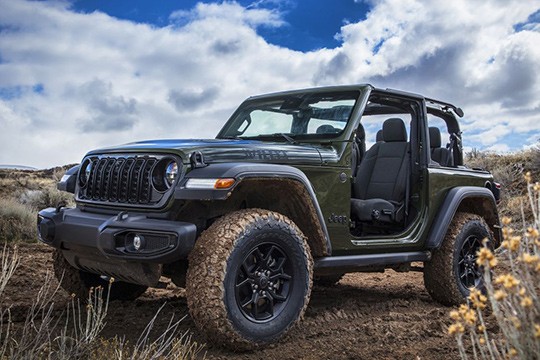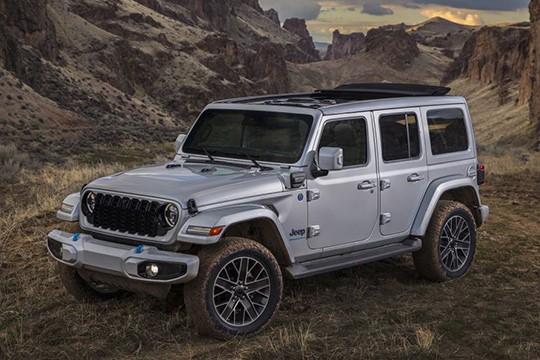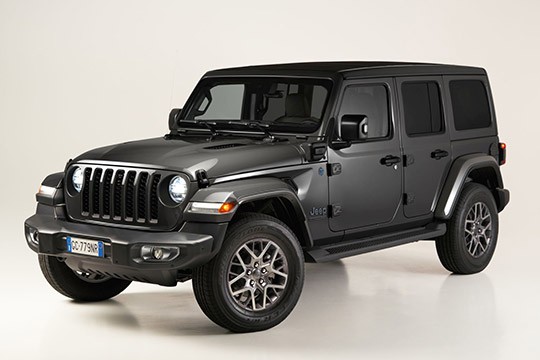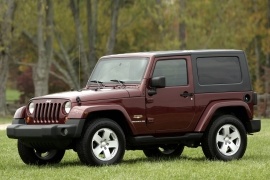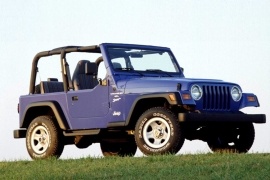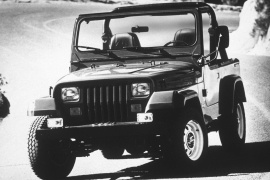JEEP Wrangler Models/Series Timeline, Specifications & Photos
First production year: 1987
Engines: Gasoline, Plug-in hybrid, Hybrid gasoline, Diesel
Body style: SUV (Sports Utility Vehicle)
Based on the same sturdy chassis of the Wrangler JL, the 2024 Willys version was a nice surprise for the American automaker, which also came with a locking differential for the rear axle.
Jeep never abandoned its heritage and also bragged about its connection with the Willys. This sturdy 4x4 car helped the Allies win WWII. Over the years, even the styling of the Wrangler lineup resembled that vehicle, and apart from one generation, all others featured round headlights, for instance. In 2023, at the Easter Jeep Safari and at the NYIAS, the carmaker introduced the 2024 model year of the Wrangler Willys.
Like the rest of the Wrangler range, the Willys featured the new, smaller grille, which was integrated into the body-colored front panel. On the sides, the round headlights were pushed furthermore inside the bodywork and thus were protected by branches, bushes, and other off-road-specific obstacles. On its sides, the 33" tires were new.
The interior was heavily upgraded with a new 12" landscape-mounted touchscreen for the infotainment system. This Connect 5 unit replaced the former 8" one and also featured Apple CarPlay and Android Auto.
The drivetrain was also improved with a Tru-Lok rear locking differential that was highly demanded by customers. In addition, the 4xe powertrain version came with the Selec-Trac full-time transfer case that added a low-range 2.71:1 ratio.
Jeep introduced a new 2024 Wrangler at the Easter Jeep Safari, at the same time as the unveiling at the 2023 NYIAS, and the 4xe version was one of the most sought-after versions of this well-known off-roader.
When the American automaker introduced a plug-in version of the Wrangler in 2021, customers were stunned. It was difficult to believe that a BEV could cope with off-road situations. Still, the vehicle proved its worthiness, and it became the best PHEV in America for two years in a row.
For the new model, based on the JL Wrangler, the 4xe version came with a redesigned front fascia. This included a smaller seven-slat grille incorporated in a body-colored panel. That was flanked by deep-dish LED headlights, which were better protected against bushes, branches, and other off-road situations. In addition, the 4xe featured blue anchoring hooks at the new, redesigned bumper. The carmaker offered as an option a factory-mounted Warn winch. Another upgrade for the car was the deletion of the aerial antenna, which was traditionally mounted on the right side of the vehicle. That was moved into the windshield. A 4xe-specific feature was the outlet plug that was placed on the left-rear quarter panel. Thus, the car could power various camping appliances, and the engine could be transformed into a gas-powered generator.
The interior was heavily upgraded with a new 12" landscape-mounted touchscreen for the infotainment system. This Connect 5 unit replaced the former 8" one and also featured Apple CarPlay and Android Auto. Unlike previous Wrangler models, the 2024 version featured power seats and lumbar adjustments for both front occupants. In the four-door (Unlimited) version, the 4xe came with a flat-folding bench fit for three. With that folded down, owners could transform the vehicle into a camper.
There were no significant changes on the engine side, but the Dana 44 axle was an improvement. Moreover, it was also provided with a locking differential.
When Jeep introduced the 2024 Wrangler, the Rubicon 4xe version was also unveiled, showing the world that a hybrid vehicle can also perform outstandingly in off-road situations.
The Rubicon version is one of the few cars in the world that could be taken straight from the showroom floor to a very difficult off-road trail and go through it without breaking a sweat. But the 2024 Rubicon 4xe can do more than that. It can silently go through a city with zero emissions at its tailpipe, thanks to the electrified drivetrain.
Sporting the same smaller front fascia as its siblings, the Rubicon 4xe also carried over the blue tow-hooks characteristic for the plug-in hybrid version. Unlike the regular 4xe, this hard off-road vehicle featured a new front bumper designed to host an 8,000 lbs Warn winch. Furthermore, the 33" BFGoodrich All-Terrain tires were fitted as standard. Like the rest of the Wrangler lineup fitted with the plug-in hybrid drivetrain, this version was also equipped with a V2L system that allowed users to provide electricity for a camper or other appliances.
Inside, there were massive upgrades compared with its predecessor. Atop the center stack, the automaker installed a 12" touchscreen for the Uconnect 5 infotainment system. But Jeep also focused on customers' comfort and added power seats. Along with the new lineup, the Rubicon also got adaptive cruise control, side airbags, and blind spot monitor. As a final detail, this version featured blue Rubicon lettering embroidered on the seatbacks' fronts.
Powered by a four-cylinder mill and an electric motor incorporated into the gearbox, the Rubicon 4xe proved that a PHEV can also forge through water, mud, and other difficult situations. Its locking differentials and the free-floating axle were part of the model 2024 upgrades.
While it wasn't the first hybrid 4x4 vehicle on the market, the 2021 Wrangler 4xe (spelled four-by-e) promised actual off-road performance and high fuel efficiency.
Jeep continued the Wrangler saga, and, despite being offered a choice of diesel and gasoline engines, it managed to implement a plug-in hybrid system for the well-known off-road vehicle. The most challenging part was to keep its legendary off-road attributes while still being environmentally friendly. For that, it mounted a nickel-manganese-cobalt battery pack under the rear seats and protected them in a sturdy aluminum case.
At a glance, it was easy to spot a 4xe from the rest of the Wrangler range due to its charging port on the left side of the vehicle, at the bottom of the windshield. The Rubicon version featured blue tow-hooks both front and rear.
Inside, the car was very similar to the rest of the Wrangler range, but with a few different buttons for the plug-in hybrid system. Also, on top of the center stack, a special lamp with integrated blue LEDs showed the charging status without the need for a designated app.
The drivetrain was the most significant part of the car with its dual-motor system. Under the hood, a starter-generator helped the turbocharged inline-four gasoline engine. Jeep integrated the second electric motor into the eight-speed automatic transmission supplied by ZF. From there, the hybrid system sent the torque to the wheels via a usual Jeep 4x4 system. Like its siblings, the 4xe featured a front and solid rear axle.
In 2018, Jeep launched the fourth generation of the Wrangler, available with either two or four doors and, most importantly, with the Rubicon version meant for serious off-roading.
Jeep had enough jokes about its hard-core product, the Wrangler, and took a decisive step when making the Rubicon version. Thus, it offered an off-road vehicle that could tackle any kind of rough terrain right from the showroom's floor. And that was not an overstatement.
It was just normal to see the Wrangler with a similar look to its predecessors. Yet, the entire vehicle was new from tip to toe and from nose to tail. But a keen eye for detail could have noticed some subtle modifications. At the front, the windshield was tilted more than on its predecessor, and the car sported LED headlights and fog lamps. In addition, the rounded shapes were a clear statement of evolution. From its profile, the exposed hinges and the high ground clearance were also a signature mark for the Rubicon as it was the seven-slat grille for the Jeep brand.
While the exterior featured subtle changes, the interior was an important evolution. There were much nicer materials inside the Rubicon Unlimited. Jeep even offered an option for a leather-wrapped dashboard. Yet, the bucket seats at the front and the narrow, flat bench in the rear didn't provide any side support. The driver could enjoy the start-button feature and a mix of digital and analog instrument panels that provided all the information needed while driving.
Just like its predecessors, the Wrangler relied on a sturdy chassis. Its stabilizer bars could've been disengaged for higher axle mobility. Moreover, the front and rear diff-locks were fitted as standard on the Rubicon version. Under the hood, Jeep installed a choice of three engines: a 3.6-liter V6, a 2.0-liter turbocharged gasoline unit carried over from Fiat, and a 3.0-liter turbo-diesel.
The JK generation of the Wrangler might be called the third generation of the rugged Jeep model, but it actually carried over the principle and the name of the WWII Willy's, through the CJ (civilian Jeep) models. In 2006, the Wrangler came, for the first time, with a four-door version.
The 2007 model was launched in 2006 after a deep and focused effort from DaimlerChrysler that asked the owners what do they want from the Wrangler range. It was a car built from scratch, but the designers kept in mind the basic design principles with rounded headlights and the body-on-frame construction.
The same seven-slats grille from the original Willys Jeep, which became an iconic look for the whole brand, was kept for the 2007 model. When compared to its predecessor, it featured a bigger bumper, to pass the safety tests all over the world. It had more rounded corners, but the overall appearance was tough.
Inside, for the two-door version there was room for four passengers, but with very limited room for those in the rear. Even if the dashboard was new, the windows control buttons were kept on the center console. Like all its predecessors, the 2007 Wrangler had a removable roof, doors, and foldable windshield. It's a Jeep thing that the car-maker kept it. It was offered with a diesel unit and two V6 gasoline engines, with manual or automatic transmission. As an option, it was offered as 2WD.
Jeep introduced a new generation of its already famous Wrangler lineup in 2006, and the world expected big changes on this model. And they were.
Developed during the DaimlerChrysler association, the Wrangler JK came in three main trim levels: Wrangler X, Sahara, and Rubicon. The latter became a true off-road gladiator fighting with the mighty Mercedes-Benz G-Class and beating it at its own game.
The Rubicon was similar in shape and size to the Sahara version from the outside. Yet, the off-road designated tires and the flared wheel arches were unique for the model. Due to the new wheels, the car was 36 mm (1.4") taller than the rest of the range. Also, at the front, the car featured a thicker metallic bumper covered with a plastic trim to respect the pedestrian protection rules. That metallic part was specially made to accommodate a winch. In addition, it was fitted with a removable hardtop, which couldn't be carried with the car. But, as insurance against bad weather, a canvas top was available.
The interior was good for two people on the front seats. It is true that it also sported a pair of seats in the back, but it was hard to accommodate anyone in there due to the limited legroom. Yet, in case of emergency, it was possible. The carmaker installed a thick steering wheel and tall seatback seats for the front occupants.
Depending on the market, the Rubicon was available with either a gasoline or a turbodiesel powerplant. It sent the power to the rear wheels, in normal driving mode, or to all four via a two-speed transfer case. The low-range featured a 4.0:1 gearing, which was unique on the market. Moreover, its Dana axles sported locking differentials. On top of that, the front stabilizer bar could have been electrically disconnected via a designated button.
Jeep made an essential upgrade on the Wrangler's second generation, also known as TJ, in 1996 when it introduced it on the market as a 1997 model.
When Chrysler bought the AMC in 1987, it didn't exactly know what to do with the Jeep Wrangler and left it with squared headlights, which Jeep fans disliked. Nine years later, the prominent American carmaker already knew what to change and made the TJ Wrangler a much better car. First of all, it ditched the leaf-springs and introduced the coil-springs and an improved suspension system, which allowed an increase in wheel-travel, essential while off-roading. Then, it made it cheaper to build in both LHD and RHD versions.
The 1997 Wrangler marked the return to round headlights. The seven-slat grille was similar to the one existing on its predecessor. Also, the carmaker kept the exterior latching system for the hood. Its windshield was pushed forward and shortened, thus decreasing the wind resistance and increasing the fuel efficiency.
Inside, Chrysler installed front bucket seats with integrated headrests for the front occupants, while in the rear, it kept the two-seat bench. Due to the short wheelbase, it wasn't easy to keep someone on the back seats for longer distances. The Wrangler TJ kept the original advantages, such as the removable top and doors and the flat-folding windscreen.
The most important update was for the drivetrain, which carried over many parts from its bigger brother, the Grand Cherokee. Apart from the suspension system, it took the steering box and the inline-six, 4.0-liter engine. However, the base version was a 2.5-liter gasoline engine, which was good enough for in-town driving. All Wranglers came fitted with a 4x4 system and a shift-on-the-fly, two-speed transfer case.
Replacing the open-body veteran CJ, the new Wrangler was the most rugged Jeep with enhanced convenience inside.
The Wrangler shared the steering, the brakes, the axles, the manual transmission, the clutch and the transfer case with the Cherokee and the Wagoner.
Also called the YJ, the Wrangler was pretty similar in design with the CJ, however, it featured square headlights and had a lower center of gravity, and featured a heavy roller protection on the side, as well as behind the front seats, offering great stability and less body roll in turns.
Inside, the rudimentary controls and the painted steel dash were dropped, the Wrangler featuring a modern dashboard with 4 gauges as standard. The front seats were comfortable, however, they had short and narrow bottom cushions.
The rear cabin did not offer great legroom for the passengers, mostly because the right front seat was not adjustable. Entering the back seats was easy with the foldable front seats. The back seats also folded if more cargo room was needed.
With a choice of two engines, the Wrangler was available with a 2.5-liter 4-cylinder unit or a 4.2-liter inline-6 powerplant, both mated with a standard 5-speed manual transmission.
The model was discontinued in 1996 when the Wrangler YJ was replaced by the Wrangler TJ.
